
Social Impact of a Declining Population
Japan’s Deepening Social Divides
Economy Society Lifestyle- English
- 日本語
- 简体字
- 繁體字
- Français
- Español
- العربية
- Русский
Behind the Low Birthrates in Japan and Europe
Fertility rates have fallen to a low level in Japan, some other East Asian countries, and Northwest European countries, but because different factors have been driving the rates down, they cannot be lumped together. Stated in simple terms, in Britain, France, Germany, the Netherlands, and the Scandinavian countries, the fall in birthrates is the result of an increase in the lifestyle options available to young people. In Japan, by contrast, young people do not have alternative lifestyles they can select, and that is why they have been having fewer children.
In industrially advanced Western nations, until around 1960 the ordinary family was one in which the husband went out to work and the wife stayed at home to raise children. So far, this is much the same as in Japan. In the 1960s, however, what might be called a “revolution in lifestyles” got underway in Northwestern Europe. As a result of the feminist movement and other factors, young people began to move away from the traditional family, entering into sexual relationships prior to marriage and choosing to cohabit without registering a marriage. After marriage, moreover, women became able to select the option of continuing to work. The young generation experimented with a variety of lifestyles, and many gained social acceptance. The fertility rate fell because young people in growing numbers opted for a lifestyle without children or with only one child. Related to this, women had a good chance of gaining self-fulfillment through work, and young people were able to leave home, live independently, and engage actively in sexual relations.
The situation in Japan was altogether different. Despite ongoing social change, young people remained firmly committed to the conventional understanding of the family, in which the husband works and the wife in most cases is a full-time homemaker. It was in this context that Japan’s birthrate fell. Sexual liberation did indeed make some progress, as premarital sex came to be accepted, but feminism and the revolution in lifestyles did not penetrate deeply into society. For instance, even today the cohabitation rate among young men and women remains under 2% (1.6% in 2010), and the out-of-wedlock birthrate is at the extremely low level of 2% (2.1% in 2008).
At the same time, while some women with careers become active in society, the majority, whether they are single or married, still wind up in insecure employment positions, many of them becoming part-time workers or temporary staff dispatched from employment agencies. As a result, having a job did not make such women financially independent, and the need for wives to depend on their husbands did not change. This set the stage for the advent of what I have named the “parasite singles.” Accounting for the great majority of unmarried Japanese, they are young people who continue to live with their parents even after attaining adulthood. In general, they tend not to have active sex lives.
It is important to note that a very large share of unmarried Japanese hope to get married. Even after the ratio of unmarried people began climbing in the 1980s, the percentage hoping to find a marriage partner sooner or later remained at the high 90% level, with only small variation up and down. In other words, because of poor conditions for getting married and creating a conventional family (with the mother at home and the father at work), an increasing number of young Japanese have not entered into wedlock and produced children despite their desire to do so. That is what has lifted the unmarried rate, and it has led to the decline in the number of children. In short, the main reason behind the fall in Japan’s fertility rate is the rise in the number of people who cannot easily form a family.
What has happened is that in the absence of any basic change in the understanding of the ideal family, a “gap in family formation,” so to speak, has emerged. On one side of this gap are those who have succeeded in creating a conventional family and are enjoying family life, and on the other side are those who have not succeeded and remain unmarried. This division of young people into two groups is one of the key features of the Japanese family today.
To further explore the characteristics of family formation in contemporary Japan, I will review the trends and draw comparisons with the situation in Western countries, focusing on points of difference.
The Decline in Couple Formation
First, the main cause of the decline in the number of children in Japan is an increase in the unmarried, as I have just suggested. More and more Japanese are remaining single. While married couples have indeed been having fewer children in recent years, this trend has been overshadowed by the rise in the number of people who never get married or marry late. In the 2010 national census, the unmarried rate in the 30–34 age bracket was 47.3% for males and 34.5% for females (figure 1). In Japan’s case, moreover, not getting married effectively means not entering into a relationship as a couple either. Unmarried young Japanese are not particularly sexually active, and they also tend not to have a steady boyfriend or girlfriend. The percentage of those with a lover has been under 40% since 1990, and it dropped to 25% among males and 35% among females in 2010. From the start, children are not likely to be born if men and women fail to bond in couples. Not just marriage but even the formation of couples has weakened in modern Japan.
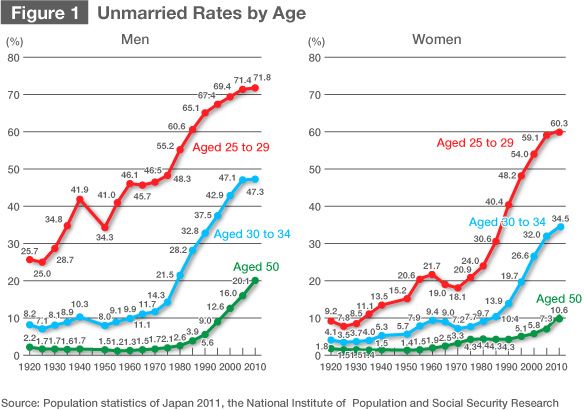
One of the reasons for the tendency to hold back from sexual relationships is that many young Japanese still firmly endorse the opinion that love should lead to marriage and then to a family. Before entering into a sexual relationship, they ask themselves whether the partner is someone they would want to marry and live together with.
Expecting to Live on the Husband’s Income
It is commonly argued that the rise in the unmarried rate is the result of an increase in the number of young women who reject marriage because they want to keep on working. In Japan’s case, however, this line of thinking is not valid in most cases. In opinion polls, only a minority of women say that their desire to focus on their career is a reason for their not wanting to get married. The great majority say that they want to get married and to be able to depend on their husband financially. Several surveys have also shown that since the start of the twenty-first century, the number of women in their twenties who hope they can become full-time homemakers has even been increasing.
Life after marriage requires money. In the minds of most unmarried women even today, depending on the husband after marriage is assumed to be only natural. Even if they expect to keep on working after marriage, they do not want a husband who is not earning ample income. When looking over prospective marriage partners, accordingly, the great majority refuse to consider men who do not make enough money or are in the wrong occupation. According to surveys conducted by the National Institute of Population and Social Security Research, moreover, this tendency has been strengthening in recent years.
To assess the reasonableness of women’s income expectations, I conducted a survey of unmarried men and women with the cooperation of the Meiji Yasuda Institute of Life and Wellness. The figures below present the results. As can be seen, most men do not care how much money their future wife may earn, but most women expect the husband to have a high annual income. Two-thirds of the female respondents (68%) said they wanted a marriage partner earning ¥4 million or more per year. The problem is that no more than one out of four unmarried men earns that much money. A glance at the two charts should be all that is needed to appreciate the huge mismatch that has arisen between what unmarried women are looking for in prospective marriage partners and what unmarried men are actually earning.
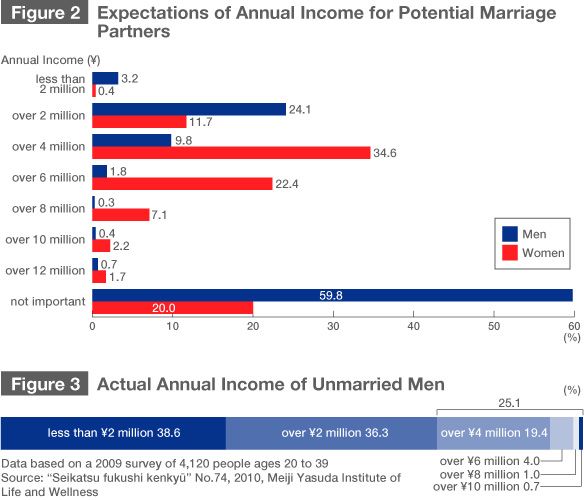
Stagnating Income, Polarization, and Job Insecurity
Few young men have an annual income high enough to attract unmarried women, as we have just seen. Here we find the main culprit behind the rise in the unmarried rate. Seen from the female perspective, there has been a drastic decline in the absolute number of unmarried men suited to the conventional family model, with the husband earning money while the wife takes care of household and child-rearing tasks. More and more young people find that they simply cannot create a conventional family despite their desire to do so.
Two trends have caused this situation. One is a relative decline in the income of young men, dating from 1974; and the other is polarization in the ranks of young male workers, dating from 1997. The relative decline in income was triggered by the first oil crisis, which struck in 1973 and ushered in the age of slow economic growth. The polarization resulted from a shift in economic structure that, ever since the second half of the1990s, has been swelling the ranks of “nonregular employees,” especially among young men. This shift created a gap between young men with stable positions as regular employees at companies and those hired as nonregular workers without employment guarantees. And this polarization then contributed to the gap in family formation. That is, regular male employees found it easy to get married, since they had a stable source of income; they were able to create a conventional family in which their wives looked after the home and the children. But nonregular employees and other men with unstable income remained unmarried. On account of their uncertain income prospects, they tended to be rejected as marriage partners. The direct cause of the decline in marriages is the increase over the last two decades in this second group of men engaged in atypical employment.
The next set of figures tracks the rates of regular employment and unemployment among the unmarried. In the case of both males and females, the rate of regular employment has been on the decline since 1992. Among unmarried men, moreover, unemployment has been edging up. Currently one of every nine unmarried male workers in their thirties does not have a job.
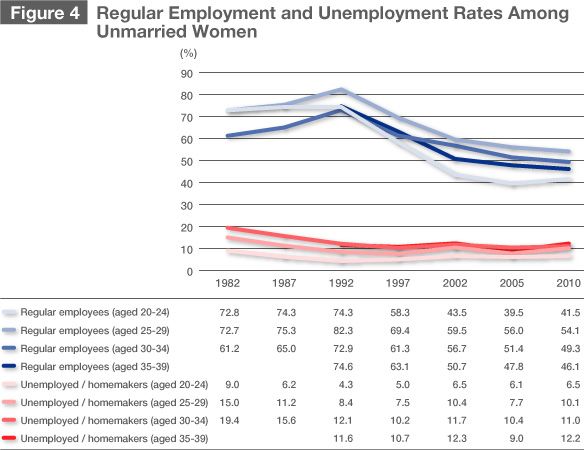
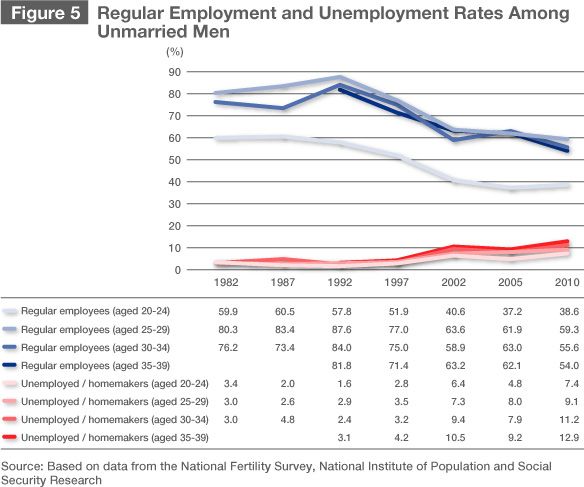
The Parasite Singles Phenomenon
The Japanese family scene would no doubt have very different features if a large majority of unmarried young people were living independently, as happens in Western countries. In countries where life is difficult for a young person living alone but becomes much easier when two people get together, marriage and cohabitation have increased. No doubt the advance of women in the workplace has also received a boost.
In Japan, however, most unmarried young people continue to live with their parents even after the attainment of adulthood. (It is estimated that among all unmarried adults, the share living with their parents is about 80%.) I coined the term parasite singles for them because most seem to have practically a parasitic existence. (My first use of the term was in a 1997 article in the Nihon Keizai Shimbun.) Even if they themselves are not making much money, they can easily get by with their parents’ support. Young people hired as nonregular workers do not have sufficient income for leaving the nest, getting married, and leading an independent life, but if they can stay in their parents’ home and use their own wages as spending money, they find themselves with more than enough money for getting by.
For daughters in particular, the family home is a place where they can wait under their parents’ wing until an ideal marriage partner comes along. Instead of having to get hooked up with a man whose income is unstable, they can adopt a strategy of remaining at home in the expectation that sooner or later they will meet a man with sufficient income for a marriage partner. This is probably one reason why young Japanese are not very sexually active. Of course, a certain percentage of the daughters eventually meet and marry men with good income prospects, and they then leave the nest. But because only a limited number of unmarried men earn an income meeting their expectations, most daughters end up staying with their parents.
The sons who do not enjoy income stability also opt to remain in the family home. They, too, can be expected to get married and move out if their wages rise high enough, or if they come across a woman who thinks their current income is sufficient. But this is not the way life ordinarily turns out. As a result, the number of sons who continue to live with their parents is on the rise.
Figures 6 and 7, which were compiled by Nishi Fumihiko (the Statistical Research and Training Institute), plot the trends in unmarried adults who were living with their parents over the 1980–2010 period. The data are for the number of unmarried people living with their parents and their ratio to all the people in their age bracket for both young adults (ages 20 to 34) and adults in early middle age (ages 35 to 44). For both age groups, the years from 1980 to 1995 saw a rise in both number and ratio. The number of young adults living with their parents reached a peak in 2003, hitting slightly above 12 million. While their absolute numbers should remain on the decline because of the dwindling population in their age group, their ratio within their group is continuing to edge up. Among unmarried middle-aged adults, meanwhile, both the number and ratio of those still living in the family home have gone right on rising.
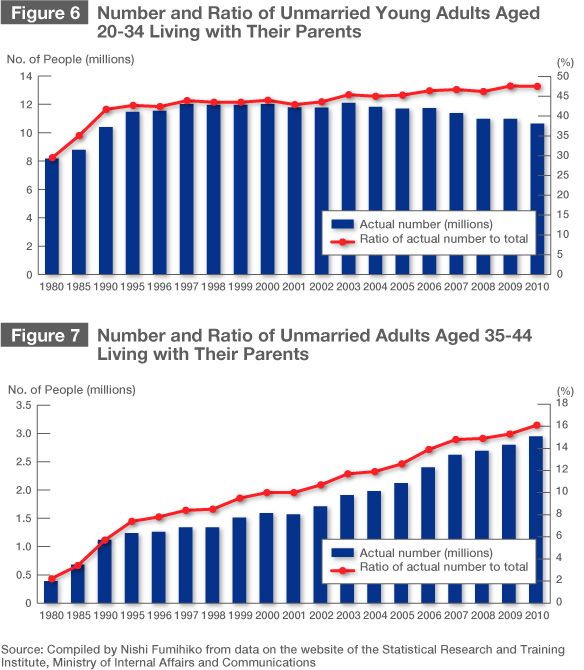
The Conventional Family Model No Longer Works
What the foregoing discussion makes clear is that the model of the family that spread when the economy was growing rapidly after World War II has now reached its limit. This is a family that has its sights set on becoming affluent with the use of a division of labor in which the husband spends most of his time working while the wife takes on most of the responsibility for doing housework and bringing up children. What we are currently witnessing is the widening gap between young people who succeed in building a model family and those who remain unmarried.
During the high-growth period (1955–72), almost all young men were able to secure a full-time job as a regular employee. Their income and status rose steadily thanks to lifetime employment and seniority-based wages and promotions, and they were able to build a model family. When the first oil shock occurred in 1973, however, young male workers suffered a sudden decline in salary growth. At that point many young women, in the course of contemplating life after marriage, decided they would be wise to put off a wedding until their prospective husbands were earning more money. The trend toward late marriage then began. They were able to stay in the family home after attaining adulthood because their parents, who had become relatively wealthy, were happy to have them there. This was the birth of the parasite singles. Meanwhile, many married women whose husbands faced sluggish income growth started doing part-time work and thereby managed to sustain an affluent lifestyle. This boosted married women’s entry into the workforce. At the time, the first cracks appeared in the family model premised on attaining affluence with a division of labor by gender. This was the dawn of an age of minor adjustments in the model.
The prospects for the conventional family further darkened in the second half of the 1990s. Around the time of the Asian currency and financial crisis of 1997, there was a sudden spurt in the category of nonregular workers called freeters: young people who “freely” hop into and out of temporary employment positions. The economy was then going through a painful structural adjustment, and many young people were unable to land a job as a regular employee. As lifetime employment was still being offered to recruits in regular employment positions, this became an age of growing disparities between the company’s regular and nonregular employees. While a regular male employee could still form a family based on the conventional division of labor by gender, one hired as a temporary employee did not have good prospects for supporting a wife and children comfortably on his income alone. The upshot, as we have already seen, was a rise in the unmarried rate and a fall in the fertility rate.
Bleak Outlook Must Be Fixed
In this context, what is the outlook for the future? Will families that are dependent on fathers with a stable source of income be able to sustain their living standard? Such families are not free of problems, but by one means or another they should be able to get by.
In other families, however, unmarried members who enter middle age and then old age will be on the increase. This will create variants of the single-parent family and the nuclear family, with one or two elderly parents living with one or more unmarried children in middle age or older. As shown above in figure 7, nearly 3 million unmarried children in early middle age were living with their parents as of 2010, and they accounted for 16.1% of their age group. Their numbers and population ratio are, moreover, still rising. In addition, their jobless rate is well above the rate for the married members of their age group.
Currently these older parasite singles are dependent on the pension benefits and assets of their parents, and it is hard to say what will happen to them when their parents die. Incidents of abuse of the elderly are on the increase these days, and the aggressors in a growing number of cases are unmarried middle-aged sons still living in the family home. This is one of the phenomena resulting from the proliferation of new forms of families.
Families now bringing up children also have issues to be dealt with. Until now, parents who were advancing in age had sufficient economic leeway to give support to sons and daughters who earned little money. In the future, however, it is quite possible that a wide divide will open up between financially comfortable and financially insecure parents. In that event, many young people in precarious jobs will fall into poverty when they cannot turn to their parents for help. This will mark the emergence of a class of young people unable to get married and also unable to live parasitically on their parents, regardless of what they want to do.
If current trends continue, Japan is bound to encounter serious social fissures resulting from the widening of a variety of gaps. For the sake of not just young people but also older parasite singles and others, the country urgently needs to implement measures that can enhance employment and strengthen social security.
lifestyle Fertility rate Parasite singles Feminism Family formation Traditional Understanding of the family Unmarried Annual income Nonregular employees Regular employees Parents Cohabitation Sexual relationships Atypical employment Part-time work